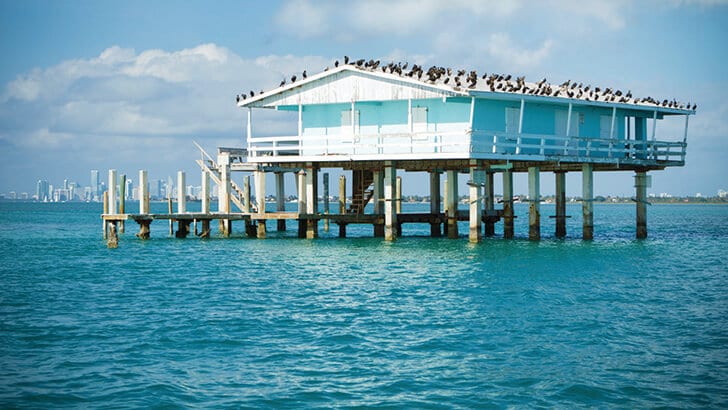
One particular type of architecture that Florida fishermen know is the fishing shack, usually a ramshackle wooden structure that looks to be on its last legs, but which can still provide a lot of comfort. Some of our bodies of water, in fact, have become well-known to boaters as places where the lucky can tie up far from shore, cook a light meal, rest and even seek shelter from a mild storm.
For example, Charlotte Harbor and Pine Island Sound in the southwestern part of our state have a number of simple, one-story, wood-frame cabins set on pilings. The temporary home-away-from-home usually has no electricity, no plumbing, no phone, and a distance from shore that precludes cell-phone service. They do, however, often have rain gutters to collect water that the fishermen can use for cooking or even drinking.
Florida officials declared the shacks navigational hazards and causers of pollution and actually began to burn some of them down in the mid-1980s, but consultants hired by the fishermen pointed out that the water around the shanties was too shallow for boats to collide with the structures and many fishermen used chemical toilets. As a result, some of the shacks have been placed on the National Register of Historic Places because of their importance in local heritage, and that should preserve them until a powerful hurricane hits them directly.
The flimsy-looking structures, usually made of pine or cypress, can nicely withstand the subtropical sun, the wind and rain. Metal gable roofs and board-and-batten siding protect those inside from storms, and screened windows keep out the flies. The shacks have a good air flow with shutters that can be propped open.
The wooden stilt houses in Biscayne Bay south of Cape Florida have long been famous among fishermen in Miami-Dade County. Standing about 10 feet above shallow water on wooden or reinforced concrete pillars, Stiltsville dates back to the 1920s and 1930s. Some of the structures may have begun as places for alcohol consumption during Prohibition and for gambling, which was legal a mile offshore, and some of them became quite elaborate.
When Congress expanded the Biscayne National Park in 1980 to include Stiltsville, the existing shacks were allowed to remain, but hurricanes and natural deterioration have taken their toll. Today only seven of the original structures remain, but the park service has added hurricane strapping to help the remaining shacks withstand strong winds. “No trespassing” signs warn interlopers to stay away, and access to the structures is limited to their owners and friends. Stiltsville has been featured enough in magazine articles that many visitors go to Biscayne Bay to see the remaining shacks. That has provided docents an opportunity to teach many non-residents about the rich maritime history of the area.
The above-mentioned are just a few of the different kinds of fishing shacks in our waters, some quite elaborate, some pretty basic, but many with a history and allure that makes them part of our fishing history.
Kevin McCarthy, the award-winning author of “South Florida Waterways” (2013 – available at amazon.com for $7), can be reached at ceyhankevin@gmail.com.